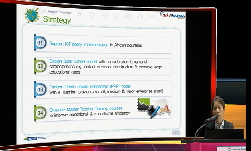The purpose of this study was to examine how seven undergraduate foreign language (FL) preservice teachers' (PSTs) motives, use and appropriation of tools, and teacher identity develop within two learning-to-teach FL contexts: the FL Education progra...
http://chineseinput.net/에서 pinyin(병음)방식으로 중국어를 변환할 수 있습니다.
변환된 중국어를 복사하여 사용하시면 됩니다.
- 中文 을 입력하시려면 zhongwen을 입력하시고 space를누르시면됩니다.
- 北京 을 입력하시려면 beijing을 입력하시고 space를 누르시면 됩니다.
How Foreign Language Preservice Teachers' Development, Identities, and Commitments are Shaped During Teacher Education.
한글로보기https://www.riss.kr/link?id=T12722827
- 저자
-
발행사항
[S.l.]: The Ohio State University 2010
-
학위수여대학
The Ohio State University EDU Teaching and Learning
-
수여연도
2010
-
작성언어
영어
- 주제어
-
학위
Ph.D.
-
페이지수
272 p.
-
지도교수/심사위원
Advisers: Mari Haneda; George Newell.
-
0
상세조회 -
0
다운로드
부가정보
다국어 초록 (Multilingual Abstract)
The purpose of this study was to examine how seven undergraduate foreign language (FL) preservice teachers' (PSTs) motives, use and appropriation of tools, and teacher identity develop within two learning-to-teach FL contexts: the FL Education program and student teaching (ST). A sociocultural theoretical lens incorporating activity theory (AT) (Engestrom, 1999) was used to frame this study. A key issue in examining PSTs' formal experiences learning to teach FLs was how such experiences influenced their ideas about best FL practices, their teacher identity developments, and commitments to FL teaching.
Data were collected using language biographies, demographic questionnaires, self-reported confidence measure, stimulated recalls, interviews, blogs, and classroom observations. Triangulation and inductive data analysis led to revealed patterns in the PSTs' FL learning histories, motives, use of tools, and beliefs about FL teaching over time and within learning-to-teach FLs contexts such as, the use of a particular approach to FL teaching, for example.
Findings indicate that often the overriding motives that shape action within the FL Education program and the ST practicum are misaligned to one another. This is partly because the university and cooperating schools have been constructed through their own historical and culturally grounded actions and social participation (Houston, 2008). PSTs' participation in each context mediated their ways of thinking, learning, and acting like FL teachers leading to tensions among differing motives, approaches to teaching FLs, and teaching tools utilized for FL instruction. As a result, opportunities existed for PSTs to problem-solve, to critically reflect upon their teaching and teaching situations, and to (re)create and work toward developing identities as different types of FL teachers. Findings also suggest that most PSTs in this study positioned themselves and (re)constructed their teacher identities during ST in relation to how they felt they were received by their students and cooperating teachers (CTs). In turn, such ways of becoming FL teachers shaped PSTs' emerging teacher identities. The specific ways in which these PSTs learned to teach FLs, appropriated various tools, and began envisioning themselves as becoming certain kinds of FL teachers further had bearing on their commitments to the field. Implications for these findings suggest ways of narrowing the gap between what PSTs learn and experience in teacher education as compared to what they learn and experience during ST.
Suggestions for further research include more examination into what the field (e.g., foreign and second language educators and researchers) conceptualizes as best FL teaching practices, longitudinal studies exploring PST pedagogical and identity development throughout preservice education and teacher induction, exploration of the ways in which PSTs' reasons for entry into the field have bearing on their commitment to teaching over time, and finally, the impact of professional organizations' (i.e., National Council of Accreditation of Teacher Education, American Council on the Teaching of Foreign Languages) expectations and standards on FL PSTs' practices, conceptualizations of FL teaching, and identity development.
분석정보
연관 공개강의(KOCW)
-

Developments in 14-19: Institute of Education
Teachers TV Teachers TV -

Education Policy at the Party Conferences
Teachers TV Teachers TV -

Early Sex Education: The Debate
Teachers TV Teachers TV -

2014 이러닝 국제 콘퍼런스 : What is the Lessons from Education Support Project~
한국교육정보진흥협회 Boseon, Kim -

Personal Finance Education: The Money Quiz
Teachers TV Teachers TV






